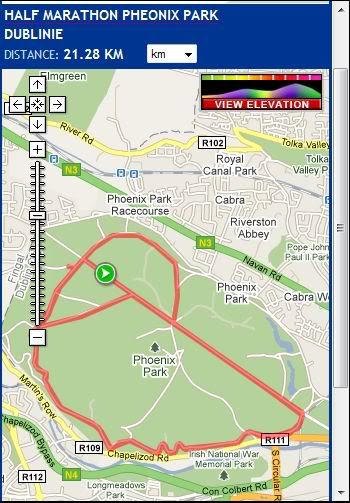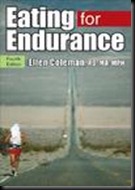Advertisement
If you have a new account but are having problems posting or verifying your account, please email us on hello@boards.ie for help. Thanks :)
Hello all! Please ensure that you are posting a new thread or question in the appropriate forum. The Feedback forum is overwhelmed with questions that are having to be moved elsewhere. If you need help to verify your account contact hello@boards.ie
IM Switzerland - An Turas Fhada
Options
-
19-04-2010 5:49pm#1I started training for IM Switzerland last November and I've been keeping a blog since Feburary. I thought I'd put some of the posts up here also in case anyone was interested. I've found I've learned a lot about sports science, physiology and sports physcology over the last few months and I tend to try to get this into the blog so that if I ever look back, I'll know what it related to.
The blog, which is a bit fancier (with photos and such) is here(http://anturasfhada.blogspot.com/).
Wednesday, February 10, 2010
The Base Period
I started training for IronMan Switzerland 2010 on November 1st 2009. Since then, I’ve been working through the base period.
The sports science concept of periodisation says that each competitive year is broken into different stages, each with different aims, levels and intensities. Each of these periods are themselves broken into progressions and rest weeks. A rest week is generally done at half the volume of the previous weeks at a higher intensity. This formula is used maxamise the body’s adaptation (eg. improvement) to the stress of training.
And so my training program for Switzerland is broken up into a few segments.
1.Base Period 1 (November ‘09 – January ‘10)
2.Base Period 2 (February ‘10 – April)
3.The Build Period (May – June)
4.Peak (June –July)
5.Taper (3rd Week of July)
The last few months – November to the end of January have been Base1. The best way to describe it is the grunt work you do to get you to the start of what you’d imagine training for an IM implies – a lot of swimming, running and cycling.
I’ve been concentrating on two things:
Strength and Conditioning; and Swimming. I attended a sports coaching seminar about 6 months ago and the biggest impression on me was made by the UK Olympic Strength and Conditioning coach. He emphasised the importance of S&C - to get a proper muscular structure in place before pushing it with training. In the elite world, he said it's the difference between retiring at 30 with arthritic knees and retiring at 35 with (almost) perfect health. Other reading has reflected this and so from November, I've been putting in 3-4 sessions in the gym a week. I put together a weights program between this program and information from Going Long - Training for IronMan Distance Triathlons (Joe Friel & Gorden Byrn). It consisted of Leg Press, Leg extensions, Calf Raises, Lat Pull Downs, Hamstring Curls and Core. Lots and lots of core.
The other thing I've been working away at was my swimming. I'm a strong enough cyclist and I didn't think building up significant miles running so early was a good idea so swimming seemed the obvious candidate to work on. I wasn't a particularly strong swimmer for the last two years. Although I didn't have a problem with the distances for shorter triathlons, one or two training sessions with Belpark Triathlon Club showed me how far I was behind. There's nothing quite like the feeling that you're holding up people in the slow lane to let you know you need to work at something. I've worked on two things. In order of importance: efficiency and endurance. Upon reading Going Long, I was surprised to see so much written about technique. Surely, it's assumed you know the basics of swimming if you're thinking about an IronMan, I thought. Not so! I guess it makes sense when you think about it - learn how to do one stroke with perfect efficiency and then repeat about 3400 times for the IM swim. So I went back to the basics: Getting higher in the water. Developing a stronger kick. Eliminating sideways hip movement which creates unnecessary drag. Turning to the side while breathing rather than an exaggerated turn to look backwards.. The advice of a swimming coach (Tony Morris) was invaluable in pointing out all of these mistakes, it's made a huge difference. I'm still in the slow lane with Belpark but with aspirations of moving up in the world. After the winter, I would guess I'm about 30% quicker in the water, by a mix of effeciency gains and strength.
I've been working on running and cycling also, just with less emphesis. This is what the last four months have looked like, time wise: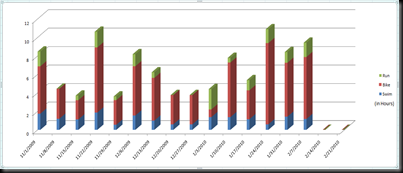
I've been substituting in a lot of other sports for sessions over the last few months too - to keep things fresh. The snow this winter has provided plenty of winter mountaineering, which couldn't be ignored. There's been climbing, mountain biking, Ju Jitsu, hurling and rafting also. These are good for general conditioning, mental toughness (possibly the biggest requirement for an IM) as well as the craic.
Most of the swim and gym sessions, I’ve done in the morning. I find it a lot easier to squeeze them in in the morning, especially if there’s a run scheduled for the evening. In general also though, it just leaves time for other things.
Over all, two things have been hard about the last 3 months. Getting up in the dark to cycle the 10km to the gym and the fact that some of the weather has, at times, been absolutely horrible. I’m not talking about the snow and ice, that was a joy (although it made cycling impossible on anything but a 2” tire mountain bike). It’s the rain and wind, mixed with cold that have made some cycles rather testing. However, the law of contrast applies. “The Good thing about bad things..” – when better weather comes along, it’ll seem so pleasant, anything will seem possible! Right?
Base1 complete.0
Comments
-
Week IM – 24: Structured Swims
I broke 12 hours training for the first time this week.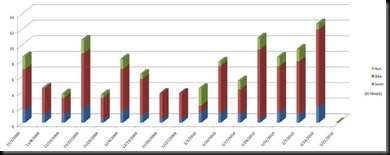
I had two good swims during the week. The past two years, while training for triathlons, I’d been aiming for a distance and nothing more. I realise now why : 1) my swim times were never great and 2) why I sometimes found swimming boring.
Structured workouts which break the swim into various sets / distances definitely make it easier to do longer distances. I’d do maybe 30-40% more in the same time following structured workouts this year. They’re a lot more interesting also – when they’re varied. I’ve been taking the workouts straight from here.
The two sessions I did this week were:
Monday
Warm up
200 Swim
2 x 75 Kick
Main Set
500 Swim @80-85%
2 x 250 @80-85% w/20 sec rest
5 x 100 @80-85% w/10 sec rest
Cool Down
200 easy
Distance 1.95Km
Wednesday
Warm up
200 Swim @ 60-65%
Main Set
800 Swim @80
5 x 300 w/30 sec rest after each
Cool Down
200 easy swim
Distance 2.4Km
(Sometimes I skimp on the warm down if I’m short of time. That’s why the Distance is less than the addition of the set)
On Saturday I went out with Belpark for a 90Km spin. I tagged on a 17km loop for a warm down afterwards so it ended up at 107Km. The roads were quite wet and muddy, so we all ended up literally covered in mud from head to toe.0 -
Week IM-20: The Physio Necessity
Having grown up playing team sports, I was never a stranger to physios (as in physiotherapists), running onto the pitch with the magic sponge and such. I’m always surprised at people who go to their doctor (or worse, just ignore) knee or back pain when often it’s just a tight muscle a physio could sort out in a few minutes.
And so, when the knees started to get sore after the long cycle and run sessions, it was to the physio I went. It’s now become a regular occurrence, every 2-3 weeks. One perspective is that physios allow the body go further than would otherwise be possible – loosening out muscles that would naturally become unusably tight when you push farther than their natural limit. Another perspective is that once you get used to going to physios to loosen out muscles, you become dependant on them. Runners in the 70’s never had physios and they were fine (..apart from the arthritic knees upon retirement in their 30’s).
Either way, it has been very useful to have the luxary of a physio who can trace certain problems to specific tight muscles and loosen them out. This week, one of the quads on the outer side of both knees had tighted up. I noticed afterwards that I wasn’t stretching it when I was stretching my quads. She loosened it out over a very painful 30 minutes.. I always seem to forget how painful those sessions are! 30 minutes pain for 6 days 23.5 hours of looseness, it’s a good trade off.
The big swim was on Monday this week – 16 x 100 meters @ 84% effort. I averaged 2:10 per 100 meters. With warmups, that was 2.4km. I did 19km of running over the week, broken into 3. I’m still trying to keep the running to short and frequent.
The cycle on Saturday was a 70km spin down to Blessington and Lackin, which worked out well. It took just over 3 hours. The weather was good, although it’s still cold. There’s still snow on most of the mountains.
The weekly totals. Twenty weeks to go: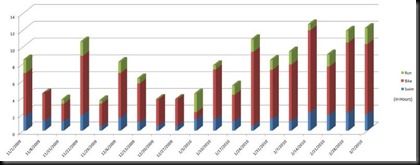 0
0 -
Welcome Conor, theres a good few Ironman logs these days, they make for great reading. Good luck with it0
-
Week IM – 18: The Break
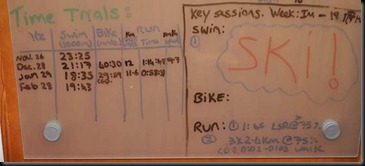
This week was a week off. I was skiing in Sweden. A week “off” isn’t in the training plan I’ve been following, but I felt safe enough taking it. I still consider myself to be on target.
It’s interesting to think that such a high volume training plan could absorb a week with a lot less work and remain unaffected. I think it will though. I wonder where the point is where one too many breaks throws performance into an un-recoverable spiral, where you’d be below the point where training could get you up to the level of the race you’re aiming for.
It essentially all comes down to discipline. The more disciplined you are, the more you can deviate from your training plan – that is; if you postpone a workout early in the week, will you fit it in on Friday morning when you’re tired, before the other workout you had planned? It’s generally easy to tell the people who would – and funnily enough it’s the people who’d never postpone a session to begin with.
I got to the gym in the hotel in Stockholm on Friday and got one good session in, at least. As well as two cycles on Saturday and Sunday when I got back. No swims left the weekly total at a restrained 86Km bike and 14.5Km running.0 -
Week IM – 17 : The Joy of Noticeable Gains
I’d usually take a rest week on the 4th week of every month – doing half the distances at a higher intensity, but I decided to keep it long after the lax week last week.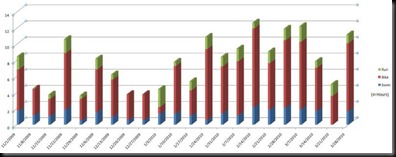
We went for an 80Km spin similar to this one on Saturday. It was a great route, one I didn’t know until now – thanks Brian!
I’ve had a bit less time in the mornings this week so two of the sessions I’d usually do in the morning, I did in the evening. One of these was one of the 2/3 weekly weights sessions. I’ve been loosely following a weights program from here.
The basic guide of it was to get a baseline of weight that you could do 20 reps of in relative comfort for all but the last few. Once you had your base line, weight should be increased every month or so, at the same time as decreasing reps per set, but increasing set numbers with higher rest times between sets. I’ve been following this without a huge amount of thought for the last 4 months but I realised on Wednesday that I was lifting comfortably 3 times the weight I was when I started, and doing three/four sets where I had been doing two. Let pull-down for instance, I’m doing 4 x 16 x 40Kg where I had been doing 2 x 20 x 20Kg.
This seems like quite a substantial gain. Am I twice as “strong” as I was when I started? I’d imagine it’s closer to the truth to say that I’m twice as good at lifting these weights as I was when I started. Even then, it was a great realisation to see these gains. I see noticeable improvements in my strength in the water in the last month or so, which I mostly attribute to the weights.
As for the cycling and running, well I haven’t gotten injured yet so the muscles are doing their job. That’s probably the biggest gain I could have hoped for.0 -
Advertisement
-
Week IM – 16: Crossing the “He’s Crazy” Line
Sometimes when talking to people that aren’t hugely into sport (or whatever you want to call endurance racing), they’ll ask about distances or training regimes. As you begin to talk, it’s often possible to observe an interesting set of stages in their reaction.
“I usually swim in the mornings before work”
-“So you’re a swimmer? That’s good. You must be tired in the evenings”
“I go running some evenings also. I do most training at the weekend”
-“Oh.. And how long is this race?”
“Fairly long – 3.9km swim, 182km cycle and a marathon”
“Oh…kaaayy”
At this point, the empathy at the start of the conversation is gone. At first they appreciated what you’re doing. A bit of a challenge perhaps. Then they hear a bit more and think they’d certainly have no wish to do such a thing.. Then they ask the distance of the IM race. At this point, there is an obvious transition. This is the point at which they think to themselves “Yeah. He’s as mad as a bag of spiders”. And that’s usually the end of the conversation.
I know this because I used to think it myself while reading a similar blog by an Irish female training for Ironman Hawaii. She was getting up between 5 and 6 am to run, before swimming before work. I thought it unbelievable at the time.
The reason I noticed this a lot this week is because of a cycle on Saturday. I was staying in a hotel for the weekend with a buffet breakfast. It seemed like the correct course of action to go in hungry. I got up at 6:45am and met Vinny down on the coast road near Dublin city. We cycled through Dun Laoghaire and along the coast road through Killiney, Dalkey, Shankhill, Shanghana and Bray. It wasn’t windy and there were no cars on the road at all. It was the perfect time to cycle..
It was somewhat of an experiment but it worked out very well. You can take my word for it!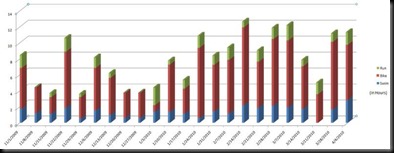
I did a lot of swimming this week. I did three sessions on Monday, Wednesday and Friday covering 5.45Km.
On Friday, I headed up to Tibradden and Three Rock mountain to run. I’d forgotten how much fun mountain running is. The top is still covered in snow, which made for some fun stepping-stone running through it in runners. There’s a great view from the top. The Wicklow mountains still look like they’re stuck in an ice age and there’s a view across the whole of Dublin and Dublin Bay.
4 Months to Switzerland.0 -
Week IM – 15 : The Real Fun Begins
I mentioned that I had completed the base period in January – that was effectively the grunt work – weights, swimming and runs in the dark. January, February and March was Build 2, where I was starting longer cycles, still keeping the running distance down. With 4 months to go, I started the Build phase this week: probably the type of training regime that you would most associate with an Ironman program: long, hard sessions – long cycles, long swim sets, mountain running and increasingly long runs. The hope is that the technique, strength and efficiency I concentrated on developing over the last 6 months will materialise to make the super-long distance stuff possible.
Next week is the start of my competitive season – I’m doing the Wicklow Adventure Race (WAR!). It’ll be ~18Km mountain running across two mountains, 55km cycle through the Wicklow Mountains and 2km Kayaking across Loch Dan. It’ll be a good, tough start to the season.
We went out for a 70Km spin on Monday which turned out to be an epic battle in gale force winds. I got a puncture also, the first I’ve gotten on the La Pierre bike in about 3000Km- fair enough. It’s no harm getting the cobwebs out of my tube changing abilities also, lest it happen in a race.
I had some shorter evening spins during the week and a good run on Wednesday.
On Saturday, I ran Lug na Coille, the highest Mountain in Leinster at 925 m (3,035 ft). We ran from the bottom to the top in 1:08 and back down in 43 minutes for a total of 1:51. I was happy to break 2 hours, although the IMRA record for the mountain run is an unbelievable 48 minutes. Unsurprisingly, a Kerry man set the record. The mountain is covered in bog so running down uncontrolled is both a lot of fun and not much impact on the knees. It’s like running on a giant sponge. There was still snow up at the top.
I learned that mountain running in cotton socks gives solid blisters:
All in all a big week this week. As the title suggests, from here on in, things get serious.0 -
-
Hi Conor, nice detailed log.. I'll check out the blog too when I have time. Best of luck for your IM quest. Is this your first one? Mind me asking what the target splits are? Why Switzerland? A few IM guys around these parts to keep you company. I must admit I'm only in my second year of Tri but the IM distance is very alluring indeed.
Good man0 -
Good man, Conor. I'm down for IM CH myself, although by your numbers so far, I won't be seeing much of you as I toil away down the back...:)
All the best...0 -
Advertisement
-
Great blog Conor. Lots of detail and interesting reading. Best of luck with IM CH. Get yourself on the A/R/T Challenge if you haven't done so already.
 0
0 -
+1. Great stuff Conor 20. Will be looking on with interest.0
-
Thanks everyone!shotgunmcos wrote: »Hi Conor, nice detailed log.. I'll check out the blog too when I have time. Best of luck for your IM quest. Is this your first one? Mind me asking what the target splits are?
Indeed, yes this is my first venture into the IM world. I guess it was a natural progression from doing triathlons. It was always there in the background, even before I did my first tri. A way to really see how far one could go.
From experience, I've been poor at estimating my times in races. So much depends on the course. You could race badly one day and beat your PB because it was a particularly flat race on a calm day. I think this will be no exception. Basically, my number one goal is to finish, and number two, to finish in a time that does my effort in training justice.
I think the heat will be by far the biggest influence on my time. I've no experience of racing in anything over 20C, so the likely temperature of high 20's or low 30's will make it tough in a few different ways - fatigue, keeping salt balanced due to sweating, dehydration etc. So, basically I'm saying I can guess at the times looking at the distances on paper but the likely outcome could be quite different. I would now guess my splits at 1:20-1:25 for the (3.9Km) swim, 7:15-7:25 for the (180Km) bike and 4:45 for the (42Km) marathon. The marathon is the wildest guess. It could be a 4 hour blaster or a 5:30 walker. This would give a 13 hours, 50 minutes finish time.
I know there are IM distance races available in Ireland but I decided that it would be more of a significant event if I went abroad to an I-dot event with some razzmatazz. I've been to Zurich before and it's a nice place. It's not too hard to get there and it's supposed to be a very well organised race. So Switzerland it is.shotgunmcos wrote: »Why Switzerland?
Conor.0 -
Great blog Conor, cool graphs.
Good luck with it:)0 -
Great blog Conor, cool graphs.
Possibly the most suprising thing about training for an IM is how much maths and statistics are involved (I'll avoid any "Mathlete" type jokes... Oh maybe just one). Measuring and planning distances, Measuring progress, plotting graphs to work out future plans.. Excel takes care of creating the time graphs in the blog, thankfully. I have a multitude of other graphs on a white board at home tracking time trials, weekly distances etc etc.
For a sport like triathlon where you're measured solely in time, stats are always going to be the centre of any training program. But there's a whole lot more information to keep track of for an IM, it transpires.
Conor.0 -
Week IM – 14: The WAR
This week was the start of the competitive season. I raced in the Wicklow Adventure Race. This was 18Km mountain running, 55Km bike through Wicklow and 2Km kayak in Loch Dan. And it was the most fun I’ve had in a long time.
I had forgotten the excitement that comes with racing and standing on the start line on the crisp but sunny Saturday morning, it all came back. The atmosphere was fantastic – a lot less competitive than most triathlons I’ve done.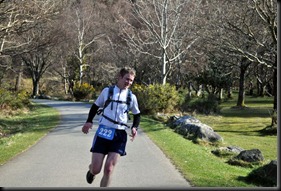
I started in the non elite group of about 250 at 8.20am. The 120 Elites started at 8. I stayed with the leading group of about 10-15 for the first run (about 11Km) over the ridge up to the top of Sprink Mountain and then back down around the upper lake. We were going at a fast pace and we started catching the elites towards the end of the run – which was essentially flying down the mountain cheese rolling style. There was a ~20km cycle then to Loch Dan for the 2km Kayak. Those both went well. I was still with the leading group on the cycle to the second mountain run about 15km from there. The group was dwindling at this stage. The cycle went up from Roundwood to the Sally Gap which is fairly punishing. After climbing for 10 or so minutes, we rolled over the “BEGINNING OF THE 10% INCLINE.. OH YES!” with a slight grin (read:grimace). By the time we got up there, 2 people had cracked and the group was down to 3. Another dropped off during the run where I was pushing very hard to keep with the other guy, he was a strong runner. It was starting to get very tough on the second part of that run where it gets very steep. The view around the top was really good though – it’s funny, you spend 20 minutes looking down, concentrating on the next step (because the ground is so uneven) then you look up and notice an amazing view all around..
We were still together at the end of the run and started the bike together for the last 25km cycle up over the Sally Gap and back down into Laragh. On the climb to the Sally Gap I got a fairly bad cramp in one of my calves. The leg locked up so I spent about two minutes trying to get it to loosen out. I’ll try and figure out whether this was to do with salt deficiency or just exertion. I’d fallen behind quite a bit at that stage so I spent the next 30 minutes or so pushing hard to try and catch up. I eventually did with about 10km to go, on the last climb before the descent into Laragh, so I decided not to slow but to go for it.. so I took off like a bat out of hell up the rest of the climb and flew down the last 6 or 7km over the other side down over the tri-bars (66km/ph was the fastest I hit). I finished in 4:28:35, 62nd out of 422 and, I think, first (or maybe down one or two if someone passed without my noticing) of the 250 non elites.
I was happy to have the legs to attack on the bike after 4 hours of hard work. Now I have thirteen weeks to get strong enough to attack after 12 hours of work.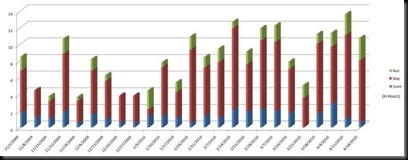
My training volume for the week is lower because I tapered for WAR. Tapering essentially means doing less than the usual training volume in the hope that the body will overcompensate in recovery – repairing muscles and so on. “Carbo-loading” is also practiced in the build up to races – this allows muscles to build up as much glycogen as possible (glycogen is the body’s way of storing carbohydrate, which is the most efficient fuel, followed by protein and then fat). In practice, a few extra plates of spuds and pasta.0 -
Week IM – 13: Active Recovery > Nothing
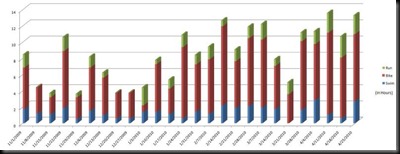
The week started relatively easily this week. On Monday and Tuesday, I did short swims (750m) in the name of “Active Recovery” after WAR. From my own experience, proactively healing an injury is always more effective than doing nothing. That may mean stretching it few times a day,using a foam roller, Physio massage or low intensity swimming. It has been proven to speed musculoskeletal recovery times and the accompanying endorphin increase has the all important mental boost.
I went to the physio on Wednesday morning to get my calfs loosened out. I had tight feet also, apparently. I’ve been instructed to stand on a tennis ball to loosen out the feet and lower leg muscles. On Thursday, I was back to a normal 2.4Km swim set.
This weekend was a big weekend. The first classified as an “Iron Weekend” by Going Long. On Saturday, I did 115Km on the bike and a 15minute sea swim in Portmarnoc. I’d organised to cycle out to Portmarnoc strand with two other hardy souls at 10:30am, so I got up early and did 60Km down to Enniskerry/Bray before that. When we got to Portmarnoc, the sea was mighty cold! Colder than I remember it on Christmas day (and I had no wet suit on then... Perhaps the obligatory yule-tide hot whisky effected the heat perception).
On Sunday I did just over a half marathon, 23Km, in 2:16:00, at an average HR of 67%. I was surprised how tired I was afterwards on Sunday. Perhaps it was the cumulated tiredness of the two days or perhaps I just need to work a lot on long runs over the next few weeks. I’ll do the latter and hope for the former.
This is the half marathon route in the Pheonix Park:
In total this week, I did 5.4Km swim, 199Km bike and 23Km running.
Conor.0 -
Week IM – 12: The Life of a Full Time Athlete
From Strength to Conditioning
I’ve often wondered before if I could cut it as a full time athlete. Get up early and train. Nap and eat in the afternoon before training again in the evening. The following day: repeat.
This weekend, I got a chance to find out. I took the opportunity of a long weekend to really push it and hit farther than I’ve ever gone before. Over the four days, I would say I approached that routine of a full time athlete.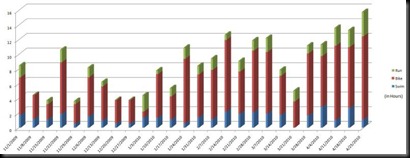
- Friday: 750m swim, 20km cycle, 7km run
- Saturday: 107Km cycle, 3km run
- Sunday: 1.5km swim, 51km cycle
- Monday: 23km cycle, 26km run
Friday was short and fast. I did a sprint triathlon during the day- 750 meters in the pool, 20km cycle and a 7km run in the evening. On Saturday, I went out on the bike with another lad doing Ironman Switzerland. We did 107Km with some tough climbs through the Wicklow Gap and Sally Gap. I went out for a 3km run afterwards, to start getting used to running on tired legs after the long IM cycle. Sunday was a 51Km cycle and 1.5km in the pool in the evening. I was quite tired on Sunday evening and I was starting to doubt my ability to complete more than a half marathon on the following Bank Holiday morning.
By the time I arrived at the Pheonix Park at 8:15am, the sun was shining and I had more energy than I did for the whole weekend. I wonder how often I’ve gotten to a Sunday evening thinking I was spent when if I had the chance, one more day training would show I was actually just beginning to peak. Either way, we did about 13km before following most of the route of a 10km race that was happening there. I had company on the most of the run but I finished the last 6-7km on my own. Everything seemed to work well – nutrition (eating 100-200 calories every 35-40 minutes), pace, concentration. I was heartened to be in perfect condition afterwards – no sore knees, just slightly stiff ITBs. The 26km took 2 Hours, 22 minutes, which included one or two breaks.
The week totaled 2.25km swim, 272km bike and 33 run.
I had set aside the weekdays this week for gym work. On Tuesday, Wednesday and Thursday, I concentrated solely on long gym sessions. This was the second last week I had set aside to concentrate on Strength and Conditioning. I’m at the “Max Strength” phase of the weights program I’ve been following and after this week, I move into Strength Maintenance – down to 2 sets from 4 for each machine and slight decreases in the weights.
Luckily for me, young men retain muscle mass for a long time without needing to directly maintain it – just using it is enough. After this week, I will only do weights once a week and I will move time increasingly to flexibility work (which will probably be the most important part of the entire plan, to stay injury free with such long runs). It’s time to turn the strength I’ve built up to purely sport specific advantage. Although, it’s already serving it’s main purpose if I can do a 26km run with no aches or pains anywhere. At last, I see the 2 months I spent before Christmas cycling to the gym in the dark, wondering how my knees would handle the load of the last few months of an IM training plan, paying off in multiples.
So, it’s been a good week tracking into uncharted territory. In another life, maybe I could have made it at as a full time athlete. One weekend at a time!0 -
Week IM-11: Nutrition, the Fourth Discipline
Last June, I set out at 7am on a Friday morning from Dublin with the aim of cycling to Clochán, on the Dingle Peninsula in Kerry – about 380Km to the south west. It was into the wind, so that made it a bit harder but the first 170Km or so went fine – it was good and sunny most of the day. It started to get tough as I was getting into Thurles, on the way to Tipparary town. I wasn’t feeling great. When I got to Tipparary, after two or three bites, I knew it wasn’t going to happen. I was too sick to eat anything that night.
This left me in somewhat of a dilemma. I wasn’t going to be able to cycle 180km without eating, especially having cycled 200 the day before.
I decided to try a new approach to breakfast. I set an alarm for 4am and had breakfast. I went back to bed then. I got up again at 5 and had another 15 minute breakfast. I repeated this 4 times and by the time 8am came around, I was flying it! I cycled through Tipp, Limerick, Cork and Kerry and had a great time on the last 30km out the Dingle Peninsula. It took 19 hours 30 minutes of cycling.
A good lesson to come out of this (apart from the joy of multiple breakfasts) is that what you eat really makes a difference to how your body performs. I put the sickness on day one down to salt imbalances – something I’m really aware of for Switzerland, where the heat is going to be a real issue. Salt and electrolyte imbalances arise because you sweat a lot while training. You then drink a lot of water, which further dilutes the remaining salt. This really only becomes an issue in exertion lasting 8 hours or more, but it becomes quite a serious issue that can essentially totally dissabilitate the body. I’ve been trying out some Isotonic drinks in training as a trial for Switzerland over the last few weeks.
I read a very good book on Sports Nutrition called Eating for Endurance. It’s a short book and I’d recommend it to anyone involved in sport. The main message of the book is that people should stick to the food pyramid. If you’re training a lot, you should eat more of the same. She asserts that supplements are mostly superfluous if you eat properly.
Some extra pieces which may be of particular use to athletes are:- Antioxidents (which help carry away broken down material from the blood stream) found in omega 3 fish oils
- Vitimen C & E
- Glucasomine (which may help repair cartilage)
- Caffeine in small doses is known to be a performance enhancer
My daily diet consists of two breakfasts, one when I get up, one after swimming/gym. A dinner at 12:30pm. A “lunch” type meal of heavy brown bread around 3pm. Another dinner at 6pm and another lunch type meal around 9pm ,with snacks in between most meals. I try to always eat something at most every two hours. This helps keep my metabolism “fast” – able to quickly turn food into energy.
For the race itself, my current nutrition strategy is- Swim: nothing during the swim bar perhaps one or two mouth-fulls of Lake Zurich.
- Bike: First 20 minutes: .5 litres water, to let everything settle down.
Subsequently (7-8 hours): 100 calories every 20 minutes (200-300 cals per hour). A mix of electrolyte, energy gels and solid foods (muesli bars, bananas). Loading towards the start / middle of the bike to compensate possibly no food during run - Run: This is going to be hit and miss and in reality, my stomach will shut down at some point during the marathon. My aim is to delay this as long as possible and keep taking on salt afterwards. About 100 calories every 20 mintes – a combo of solid or liquid nutrients. Alternate electrolyte Sports Drink and Gel + Water.
This week was a rest week, so was mostly easy cycles. On Sunday, I ran the Kildare Half Marathon. This went really well and I ran it faster than I expected – 1:36:11, finishing in 127th place out of about 2000 (2 minutes behind Vinny). I was very stiff afterwards – from a mix of the fast pace and the fact that it was on concrete. It was many times harder than the 26Km run in the Pheonix Park the Monday before.0 -
Week IM-10: Preparing for the heat
Switzerland is going to be hot. Much hotter than I’m used to training in – especially considering the last six months, I’ve spent adapting to training in really cold conditions.
I had hoped to get to France or Italy for a week of training all day in hot weather but this now looks very unlikely, especially with Half Ironman UK in the middle of June. I’m going to have to try and find some other way.
What I’ve arrived at is the sauna. I can’t really train inside a sauna, but I can use it just before and after training. On Sunday, I swam 2.8km before getting straight into the sauna. It’s not pleasant but the feeling of being too hot is something I’d be wise to to get as used to as I can, I feel. It’ll likely be high 20’s or low 30’s (C) in Zurich on race day. I'd appreciate any advice from anyone who has experience competing in hot climates - how did you train for it? Did you do anything special with nutrician or clothing?
I’ve also been practicing with isotonic / electrolyte drinks. These basically are a mix of carbohydrates and salt to replace the energy you’re burning and the salt you’re sweating out. I’ve tried Zym and High 5 Isotonic so far. They both dilute into 1 litre of water. Zym tastes a lot nicer but it’s caffeinated and I want to avoid caffeine at least until part of the way through the marathon. High 5 tastes so-so. I’ll use it for earlier in the race if I don’t find something better.
Injury reared it’s unwelcome head this week. In the days following the Kildare Half Marathon, it was sore while running on the outside of my right leg (not the knee). I wasn’t sure what it was so I rested it until Sunday. Even so, it started almost immediately when I started running on Sunday and so I had to abandon the run after 2km, which was very frustrating. I’ll go to the physio on Tuesday to try and figure out what’s wrong. I’ve had a few other niggly things this week also– a sore throat and a cough- and combined with the running problem above, it resulted in a weekly total falling far short of what I had planned. It will be something of an unplanned taper for the first triathlon of the year next Saturday – the Velentia Island (sprint) Triathlon in Kerry.
I did one 2.8km swim on Sunday, which went well. On Saturday, I cycled down to Greystones with the two lads who became the first Irish people to cycle around the world. They left 18 months ago and finished the last part of the circumnavigation, from Dublin to Greystones on Saturday afternoon. It was good fun and a good spin back.0 -
Advertisement
-
Hey Conor well done on that mammoth cycle across Ireland recently. A few of us boardsies doing Valentia at the weekend. The weather looks to be a warm one, could even be 20 degrees so some warm weather racing for ya for practice
 0
0 -
shotgunmcos wrote: »Hey Conor well done on that mammoth cycle across Ireland recently. A few of us boardsies doing Valentia at the weekend. The weather looks to be a warm one, could even be 20 degrees so some warm weather racing for ya for practice

I certainly hope so.. If you did Velentia last year, you will remember the hail stones during the cycle! I remember deciding to get Lock Laces while trying to tie the laces on my runners with numb hands in T2. Griffin100 summed the feeling up well in his training log: "There was one lad beside me on the ground crying with cramp whilst a medic tried to stretch out his legs - not nice."
It was good fun all the same! I'm looking forward to comparing my time with last year. I find the course has such a big influence on your time that you can never really compare two different races of the same distance with any degree of accuracy.
Conor.0 -
I sure did, it was my first OW swim too! The head freeze from the hailstones on the bike was something else. It will be interesting to see if splits have improved alright, although its the straight swim this year as apposed to last year and the transition area has moved0
-
IM – 9: Velentia Island Triathlon
I did my first competitive triathlon of the year this week – Velentia Island Sprint down in Kerry. I plan to do one competitive triathlon of each length this summer – Sprint, Olympic (Tri-Athy on Saturday 5th June), Half Ironman UK on June 20th and IronMan Switzerland in July. This was the sprint.
Everyone got the ferry from the island to the main land and the swim went from there back to the island. I was in the second wave. Someone blew an air-horn in the crowd about two minutes before the first wave was about to start and a rather large false start ensued.
I completed the swim in 13:42. When the second wave started, I was towards the front. It took me a while to settle as there was a lot of jostling and it was a tight pack for much of the section – elbows and feet flying everyone. I was happy enough with 13 minutes.
The cycle went well also (36:15). It began with a climb for about 3km before leveling off for a lap of the island, with some incredible views. I was passing a lot of people from the first wave of 250 and I had a good battle with a triathlete from Pirhanha tri club. These are great to push you on. I had one bottle filled with zym caffinated isotonic, and it worked quite well although it’s quite carb heavy so I was craving water by the end.
I had good transitions but unfortunately, despite resting a lot during the week, the injury I picked up during the Kildare HM came back almost as soon as I started running. It’s tendonitis in the right leg owing to stiffness in the hip, ITB and calf. It slowed my run a good bit – 23:13. I’ll be working on this a lot next week.
I finished in 1:16:16. In 126th place out of about 520. On Sunday, we went for a really enjoyable cycle around the island, part of the Ring of Kerry and Lumanagh hill. In weather as good as that, there’s nowhere better than Kerry.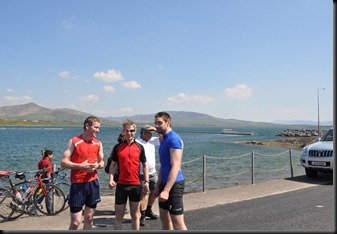
(After the race; myself, Vinny and Kevin.)
I didn’t run at all this week before Saturday to let the tendonitis clear. I tapered on Friday before the race. This resulted in quite a low weekly total:
Most importantly, I took some learnings from Velentia for Switzerland:- The bottle on the bike was warm by the time I got to the cycle. For Zurich, have an ice pack to keep them cool.
- Bring water as well as isotonic on the bike.
- Put good sun cream on my whole arm if I’ll be wearing a sleeveless top.. Which I didn’t for Velentia resulting in some humorous looking sunburn.
- Bring a hat.
It’s all a learning experience. 9 weeks to go.0 -
Nice race report Conor. Hope the leg clears up soon. Getting injured at this stage is something I dont event want to think about.0
-
Thanks for the report Conor20. Good race, shame about the run and hope the leg clears up too. Sunday was a lovely day for a cycle I would have loved to have gone up around the mountains
 0
0 -
IM – 8: Fish Mode and the HTFU Philosophy
I removed all running from the training plan for this week to try to get the tendonitis a chance to clear. I took the opportunity to push the swim distance on a lot.
Over Tuesday and Wednesday, I did two swims which covered the IM distance of 3.9km and for the week, I covered just under 8Km. I wanted to push it quite a lot to see how I handle long swims with no breaks (as in 2.5km straight instead of 5x500m with 20 seconds break in between each set). The answer turns out to be quite well.
There are several defined periods, I find after about 200m, my arms get a bit sore. This lasts about 200-300 meters and then disappears (essentially the warm up). Some time between 750m and 1Km, I enter a period of flawless swimming. It only seems to happen when the water feels cold, so I must be fully warmed up at this stage. I can only describe it as “fish mode”. Nothing feels tired, my HR and breathing stabilise to a comfortable level and I can swim my fastest then.
After about 2km, my form starts to get more ragged and I started to lose concentration. Bearing in mind this is after around 80 laps of the 25m pool. I concentrate hard on form at this time. Worse form means less efficiency, which means slower swimming which equals worse form and so on..
Finally, the minute I switch from counting the lengths I’ve done to how many I have left (typically around 250m from the end and the light appears at the end of the tunnel), my form returns and I can almost always finish strongly.

Holding concentration really is everything. It’s interesting to note that many ultra endurance swimmers have psychological problems. It is, after all a very solitary pursuit. The Man Who Swam the Amazon describes Martin Strell’s mammoth swim of 3,274 miles from the source to the finish of the Amazon – one of the most dangerous rivers in the world. At the beginning of the swim, he had people in boats looking out for crocodiles, snakes and the awful sounding Caribu fish (they are an invasive species..). In the last few days of the trip, Strell declared that he had been talking to the fish under the water and had made friends with them. There would be no need for danger spotters anymore.
I plan to make friends with as many of the species in lake Zurich as I can prior to the race.
On Saturday, I spent 5 and a half hours on the bike with Justin, another guy training for IM Switzerland. The weather for the first 2 hours alternated between ‘heavy rain’ and ‘downpour’. It certainly wasn’t easy but we completed it eventually, after a puncture. Coming back over the Sally Gap, we experienced some very unusual conditions – small pockets of blue sky, almost like the eye of a hurricane surrounded by rain clouds, inside which visibility was almost nothing.
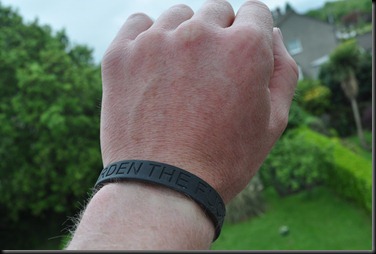
I have a wrist band for when times get very tough like they did on Saturday. It’ll be no stranger to endurance athletes. It simply says “Harden the F**K Up”. IM training is no time to feel sorry for yourself. The HTFU band is a good reminder of that.0 -
IM – 7: TriAthy Olympic. Race 2 of 4
On Saturday, I did the TriAthy Olympic Distance triathlon in Athy, Kildare. The weather was good and everything went smoothly in the morning (long registration queue aside). The race was set off in waves starting with the eldest groups. The aim was probably to have everyone finishing as close to each other as possible. It must be disheartening to be passed be loads of people though.
The swim went well. I started in the first third or so of the swimmers and finished the 1.5km in 31:14. The swim was 600m against the current of the river Barrow and then 900m with it. The majority of the swimmers swam close to the bank against the current. I stayed a little farther out in a group of 3. After rounding the bouy and turning downstream, the groups broke up and everyone powered down with the current. I had a goggle break for the first time in a triathlon. After trying to fix it a few times, I gave up and just swam with the one eye that worked. It didn’t actually make much difference.
The cycle was quite fast. There were a lot of people on the course due to the aforementioned wave setup but the roads were wide so this didn’t cause too many problems. I changed the gearing setup on my bike last week for two upcoming races: the Wicklow 200 and Half Ironman UK. Both have some tough climbs, and so I changed to a compact crank set (this gives smaller front chain rings). This essentially took away some of the “hardest“ gears and put in some “easier” gears.
I won’t try and explain much about gear ratios, because frankly, I don’t know much about it over the simple math: engaging a smaller chain ring at the front means each turn of the cranks turns the wheel less, and so it requires less effort. The opposite is true also – bigger front chain rings, or smaller back ones mean each turn of the cranks is harder, but gets you further. Here’s an article on Compact Crank sets.
I wondered if I’d loose power on the bike at the higher end because I’ve sacrificed the harder gears for easier mountain climbing but I didn’t. I have a high cadence compared to most cyclists anyway, probably because I grew up beside the mountains. The cycle was a two lap course of the 20km loop. There were no turns or hills to speak of so it was simply a matter of keeping a good aero position and powering for the full distance. I finished the cycle in 1:11:19 which I was very happy with. The fact that I wasn’t tired at all made it very, very difficult not to do the run – I was on to set a good time.. But after the injury problems during the Velentia run, I’d been advised to take 10 days off running. Knowing that tendonitis has the potential to go on forever if I keep inflaming it, I resisted the temptation and called it a day there.
When I got back to Dublin on Saturday evening, I went out on the bike into the mountains for a while. I felt like I had a lot more to give so it was worth using it.
I Sunday, I completed my first full, straight IM swim of 3.8km in the 50m Westwood pool in Clontarf. It took 1hour 24. I’m happy with this considering I generally swim about 10% faster in races, owing to the extra buoyancy of the wet suit and the other competitors. That would mean translate to about 1:17 – 1:20. I was a small bit stiff afterwards but not too tired. I hit the sauna afterwards again for some “heat training”. For the week, this was by far the biggest swimming week of my training so far – 10.25km.
After the swim, in lieu of being able to train for running by actually running, I walked the 15km home with a heavy rucksack. I figure it might do at least something to keep the running muscles ticking over. I actually found a lot more tiring than a 15km run.
Monday, Tuesday, Thursday and Friday were composed of an AM: Swim and PM: Bike. My morning weights sessions have now all been replaced by swims. I think I benefitted hugely by the 6 months I worked on Strength, but now it’s time to spend the last 6 weeks concentrating solely adapting the body to the very long distances of the IM race.
This was weekend number 1 of 3 competing - I’ll be doing the Wicklow 200 next Sunday and Half Ironman UK the following Sunday, June 20th. I think I’ll get the first real picture of how prepared I am come the finish line of HIM UK. I’ll be wearing my Ireland cycling jersey and I’m hoping for some good signs.0 -
Week IM – 6: The Wicklow 200, The IM Cycle
Today, I did the Wicklow 200. It was a 200km cycle through the Wicklow Mountains and the towns that surround them. It started in Greystones . This was the first full IM cycle I have completed this year. Here’s how it went:
0km – 50km: (Sally Gap) (The race started in Greystones and climbed up to the Sally Gap before the long descent to Kilbride. The weather started off fine but out across the Sally Gap, it was strong winds and heavy rain. That’ll toughen us up! I started cycling with a fellow triathlete, Noel, and we set a very fast pace. We started a bit later then many others (you could start any time between 6:30 and 8:30). We both felt strong as we passed the 50km but Noel summed it up well by saying “Don’t get carried away.. this is still very much the honeymoon period”. The descent was fast and it really needed a lot of concentration in the rain and wind. I’m quite a fast descender but in rain, I tend to under steer on corners, so I was a bit more conservative than normal.
50km – 110km (Donard): We flew through the first water stop at the 50km mark without stopping. We continued to set a good pace on what were at times very difficult road surfaces. We stopped then for 20 minutes at the first main pit stop in Donard at 80km. We set a good pace after Donard and I tagged onto a group of strong cyclists for a fun 15km of fast, interesting ascents and descents between Donard and Brockna.
110km – 185km (Slieve Maan, Shay Elliet climbs): It was at some point during the ascent of the punishing Slieve Man climb that the honeymoon period ended. I struck out on my own soon after Donard to essentially simulate the Ironman as much as possible, using the tri bars and pushing it hard. I passed many pentalons. Before Slieve Man, there was a smaller ascent and fast descent before the real thing. And it was obvious when it arrived. It’s a long ardius climb that reduced several people to walking with their bikes. I grinded up most of the climb with an American chap, passing a lot of people on the way up. And it was tough. It lasted a long time and seeing the tips of the big flags errected at the summit was like an oasis in the desert of pain. The descent from Slieve Maan is long and fast. My speedometer tells me the maximum speed I hit was 67Kmph, but it underestimated the race distance by about 30%, so I imagine it also underestimated that max speed.
At the bottom of Slieve Man, there was little mercy as the Shay Elliet Climb begins almost immediately. It was another tough one. It’s a shallower climb but almost as long. The Tour of Ireland King of the Mountains markings were on the road on the way up. 3km to the top.. 2km.. 1km.. 500 meters.. There were a group of people cheering on the last 100m of the ascent so it seemed apt to sprint it. It’s quite amazing how much better people cheering can make you feel. Or at least how much better you perform so you look like you feel better to them.
Between 150 and 175km, things got tough. I forwent the second sandwich stop at around 145km and in hindsight, it would have been a good idea. At that point, I was still pushing hard on the tri bars and averaging a good 32-33kmph. Around 155km, I felt my stomac beginning to reject food. It was probably sick of energy gels and salted isotonic (4:1). My cycling became more sparadic – pushing too hard for a while then needing to ease off a lot. I was passed by many pentalons.
After the climb just outside Avoca, I realised I was flagging a lot and it was really tough. When you’re on your own, when things are going badly, it seems your mind focuses every single neuron in your brain on the reasons you should stop. I reached for a HyperBoost bar that we had received in the race goody bag. It’s a dark chocolate covered brick of pure, caffinated energy. It could feel my tummy think about it for a while before deciding to moodily crank back into action. I was back over the bars and making good pace by about 175km.
175km – 200km: Having been through the somewhat of a wall (although still not out of the woods), I ran into a follow boards.ie person (Buffolo). I recognised the boards.ie top. He was a good cyclist and we did about 10km together before he went ahead. This really made things a lot easier for this period. Around 185km, things were getting tough again (although I knew I would finish at this stage regardless of whether I could eat any more or not). One thing I noticed as time went on was that the pentalons were getting bigger. These large globuals of cyclists were swallowing people up and they were sticking with them. I too suffered this sticky fate around 185km. I heard a whirring from behind and thought it was an electric car. It was actually a 25 man pentalon. It was travelling about 20% faster than I was and the first 6 or 7 riders went around and moved in front of me. At this point, they began breaking the wind and I sped up by exactly 20% so the rest of the riders filed in behind me. I had been subsumed by the pentalon.
If I was to put a figure on the effort needed to cycle inside a tight pentalon against cycling in wind alone, It’s probably about 50% of the effort. That’s a huge difference. After about 3km, as tired as I was, I thought to myself - “This is a good cycle, but it’s not an Ironman cycle”. I knew I had to finish this thing alone so I dropped off the end of the now very large group and faced the wind alone for the last 13km. I’m glad I did. These were those last few Km when I knew I had the course beaten and I hit the tri bars for the last jaunt back into Greystones.
Getting off the bike at the finish line was a strange affair. I couldn’t straighten up for about 30 seconds. I didn’t feel like I could run a marathon. Eventually I loosened up and had a plate of pasta, which went some way to settling my stomac. Once I had the bike in the car, I went for a short run. I was suprised that my legs were fine, they were tight but not tired at all. I think on race day, it’s going to come down to settling my stomac enough to eat sufficient calories to make the marathon possible. This may mean a large salty meal in T2. If this is what it takes, then that’s what I’ll have waiting there.
After I drove back to Dublin, I went for an 8km slow jog / fast walk. I felt good. Maybe I will be able to do a marathon after all.
Some stats:- Distance: 200km
- Time from start to finish: 7:59:58
- Time cycling: 7:32:30 (27:28 at stops)
- Calories burned: 4581
- Calories consumed: ~1900: 1 Chicken Sandwich, 2 caffeinated energy gels, 2.5 litres of isotonic, 2.5 litres of water, 2 Meusli bars, 1 jam sandwich, 1 HyperBoost cafinated energy bar.
- Max HR: 82%. Average HR: 66%
- Max speed: 67Kmph. Average speed: 26.5Kmph
The main lesson for Zurich is a lot more solid food is required. I’ll have several sandwiches, flap jacks, muesli bars and a pasta dinner at both transition and the bag drop at the half way point on the cycle. If I need them, they’ll be there.
On Monday, I did a tough 120km mountain cycle to get ready for the WW200. I went over the Sally Gap, through Laragh, Over the Wicklow Gap, through Blessington and back over the Sally Gap. The weather was really bad – driving rain and wind - and it took everything I had to make the last climb up to the Sally Gap into the wind. I also managed to leave my phone and keys in the coffee shop in Laragh (although I assumed I’d dropped them out of my pocket somewhere), and this didn’t add to the pleasure of the cycle! Luckily, someone handed them in and my kind girlfriend picked them up without me knowing. I was glad to be home, but also glad to have done such a tough cycle.

This cycle meant I broke 400km on the bike this week (and gave my biggest training week so far). A total which gives me a lot of confidence and I can feel myself getting stronger over long distances. Next week I will return to running and compete in Half Ironman UK.
Today’s IM cycle was the second of the boxes checked (Swim and Cycle) and I really feel like I achieved something today. As I’m frequently reminded, it’s not the destination that’s important but the journey. Amen.. But the destination is looming.0 -
Advertisement
-
Best of luck for the 70.3 in the UK...supposed to be a savage course!
BTW, what's your plan for Zurich?
I'm out with Aer Lingus on the Friday, back on the Monday.0
Advertisement
